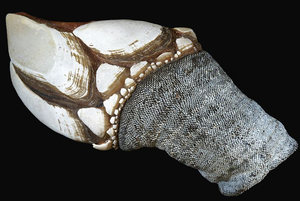Goose Barnacle
Latin Name
Pollicipes polymerus
Group Name
Invertebrates
Habitat
Goose barnacles are crustaceans native to the west coast of North America, occurring from southeastern Alaska to Baja California. Goose barnacles prefer rocky, exposed coastal areas, occurring in the mid- to high intertidal zone on bare rock, acorn barnacles, or sea mussels, often in distinctive in rosette-shaped clusters.
Species Description
Goose barnacles have a unique shape in comparison to the more common acorn barnacle, resembling the neck and head of a goose. They have a muscular stalk or peduncle which attaches to a substrate with cement glands. The stalk is topped by an oblong head or capitulum covered by white shell plates. Most of the rest of the body is normally brown or grey with the lower stalk, foot and cement glands often bright orange. In some areas, the capitulum may be bright red. They can grow to a length of about 8 centimetres. Like some other crustaceans, goose barnacles are hermaphroditic: with eggs and sperm present at the same time, although they do not self-fertilize. Adults brood young developing embryos and then release planktonic larvae that settle on suitable substrate after 30-40 days. They may live up to 20 years.
- Date modified:

